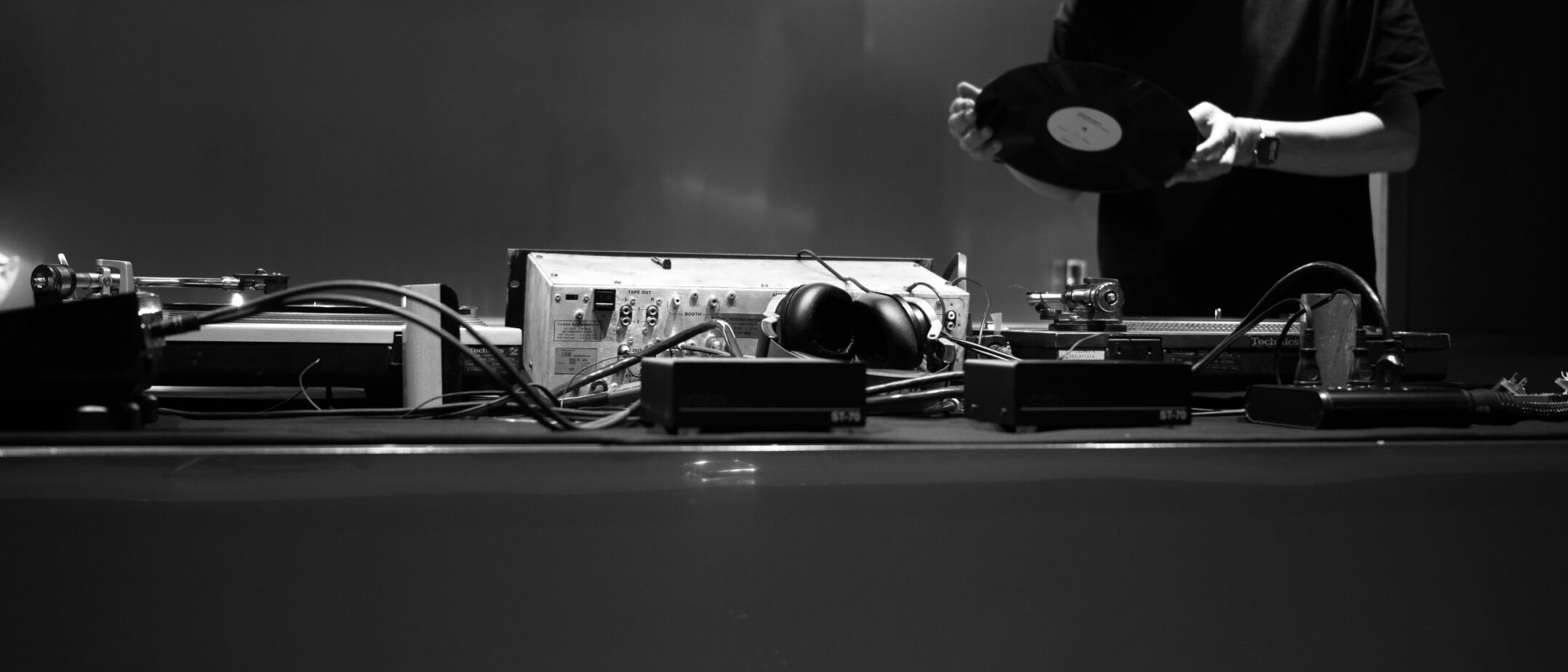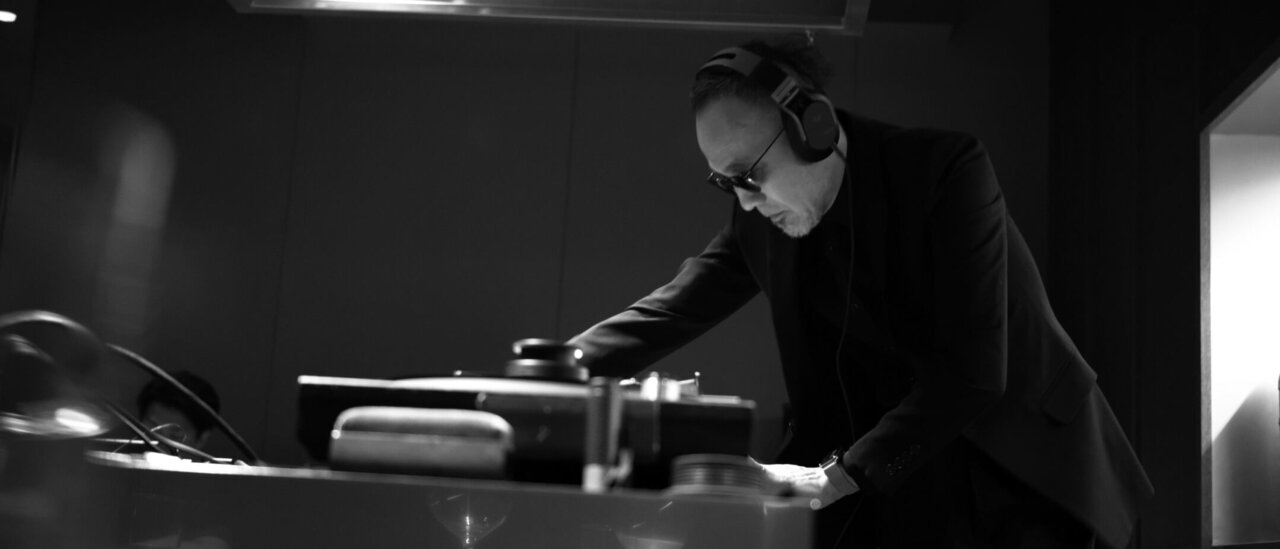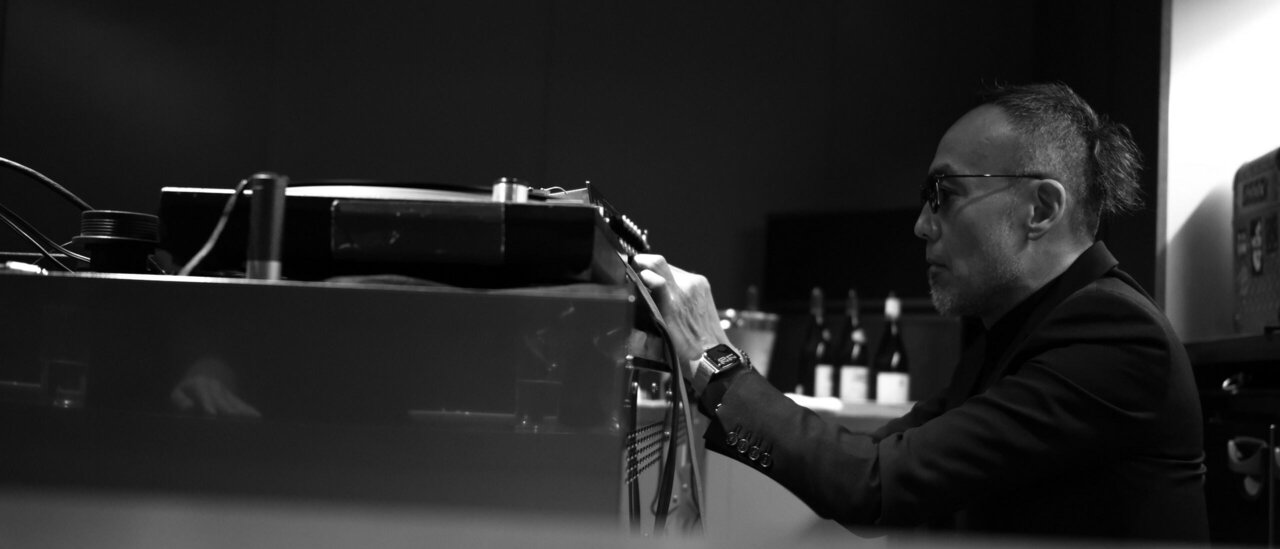
LOUNGE /
MUSIC
2025年10月17日
松浦俊夫|究極のアナログプレイに挑む一夜限りの音の旅
MUSIC | MUSIC FOR LIFE
MUSIC FOR LIFE 特別編。10月7日、暑さの残る福岡。カウンター13席の鉄板焼きレストランで行った一夜限りの究極のアナログプレイの模様をリポート。普段は鉄板で肉を焼く音が響くが、その夜は鉄板の上にターンテーブルを置き、音を奏でた。
Text by MATSUURA Toshio
今年最大の挑戦として、日本のどこか。クラブでもバーでもない空間で、究極のアナログプレイに挑む一夜限りの音の旅。舞台は九州・福岡だった。現地の友人、鮫島太一氏が営むカウンター13席の鉄板焼きレストラン「さめじま精肉店」。普段は鉄板で肉を焼く音が響くが、今夜はその鉄板の上にターンテーブルを置き、音を奏でる。
アイデアが生まれたのは1年ほど前。
高田馬場Bar stereoで定期開催している「レコードを使ったライブコンサート」。
熱をはらむ静寂の中、恐れず次のレコードに針を落とす。
音が鳴り、空気がわずかに震える。一音ごとに前へ。
いつしか、静寂を破るように歓声が上がり、店内に熱が広がっていく。
きっと新しい地平が現れる。そう信じて、踊らせる音楽から心躍る音へ。
その感覚を信条にした夜が徐々に定着していくなかで、東京以外でもそのスタイルでプレイしたいと強く思うようになった。80年代から縁の深い街、福岡でも実現したいと考えたとき、鮫島氏が肉を鉄板で調理する姿がDJにオーバーラップした記憶が蘇った。
音響はレコードショップLighthouse Recordsのファウンダーであり、イベントオーガナイズからDJ、音楽制作まで手がける増尾則秀氏に依頼した。無の空間にシステムを持ち込み、ゼロから音を立ち上げてもらった。
スピーカーはKlipschorn。ホーンの奥から吹き出すような音が空気を震わせ、小さな音にも血が通う。
まるでホールをそのまま持ち込んだような感覚だ。
カートリッジはOrtofonのMC X40。透明で抜けのよい高域から厚みのある低域まで、音楽の芯を鮮やかに描き出す。透明感、定位、スピード、ダイナミクスに優れ、音楽を生き生きと浮かび上がらせる。
この夜は実験であり、冒険でもあった。利益は度外視した。
だが、イベントの開催や機材にかかる費用は少なくなく、結果として誰もが気軽に参加できる金額ではなかった。数よりも質を選んだ結果、不安はあったが、告知から数日で満席。各地から音を信じる人々が集まった。
この場合、参加者というより「共感者」と呼ぶ方が相応しいと思う。
告知を始め、興味を示した人にだけ都市名を伝え、会場は直前まで伏せた。
特定されることなく、音だけを目指して集まる旅にしたかった。
10月とは思えぬ暑さの福岡。昼食を終え、機材搬入に立ち会う。
スピーカーの設置が終わり、音を出した瞬間、ここにしてよかったと確信した。
増尾氏が気にしていた音の回りも問題なかった。ホテルに戻り、シャワーの水が火照った身体を静かに冷ましていった。
It was to be my greatest challenge this year,
a one night music journey, an attempt at the ultimate analogue play,
in a space that was neither club nor bar, but somewhere else entirely.
The setting was Fukuoka, Kyushu. My friend Taichi Samejima runs Samejima Meat Shop, a teppanyaki restaurant with only thirteen counter seats. Normally the air there is filled with the sound of meat sizzling on the iron plate, but tonight the turntables were placed upon it, and the sound would come from vinyl instead.
The idea had taken shape about a year earlier.
At my regular event in Takadanobaba, A Live Concert Using Records, I drop the needle fearlessly into the silence charged with heat. The music begins, the air trembles slightly, and I move forward, note by note.
Before long, the stillness breaks — voices rise, and warmth spreads through the room.
Believing that new horizons would appear, I shifted from music that makes people dance to music that makes their hearts dance.
As that feeling became established night after night, I began to wish to take this style beyond Tokyo.
When I thought of bringing it to Fukuoka, a city I have been connected with since the 1980s, the image of Samejima cooking meat on the iron plate — his movements overlapping with those of a DJ — came back vividly to me.
I asked Norihide Masuo, founder of the record shop Lighthouse Records and a man deeply involved in event organisation, DJing, and music production, to handle the sound.
He brought in the entire system, building it from nothing within the space.
The loudspeakers were Klipschorn — horns that breathe, sending air into motion, giving even the smallest sound a sense of life.
It felt as though an entire concert hall had been transplanted into the room.
The cartridge was Ortofon’s MC X40, its clear, open high range and solid low end tracing the very core of the music.
With remarkable transparency, imaging, speed and dynamics, it brought the sound vividly to life.
That night was both an experiment and an adventure. Profit was never the aim.
Yet the costs of staging the event and hirering the equipment were not insignificant, and the result was a price that could hardly be called casual.
Choosing quality over quantity, I worried whether anyone would come — but within days of the announcement every seat was filled.
People who truly believed in sound gathered from across the country.
In this case, it felt more fitting to call them kindred listeners rather than participants.
Only those who showed real interest were told the city; the venue itself remained undisclosed until the very last moment.
I wanted it to be a journey where people came not to a place, but to sound itself.
Fukuoka in October still carried the lingering warmth of summer.
After lunch, I went to oversee the installation of the equipment.
When the speakers were finally in place and the first notes sounded, I knew this had been the right choice. The acoustic reflections Masuo had worried about proved no problem at all.
Back at the hotel, the shower’s water quietly cooled my heated body.
アイデアが生まれたのは1年ほど前。
高田馬場Bar stereoで定期開催している「レコードを使ったライブコンサート」。
熱をはらむ静寂の中、恐れず次のレコードに針を落とす。
音が鳴り、空気がわずかに震える。一音ごとに前へ。
いつしか、静寂を破るように歓声が上がり、店内に熱が広がっていく。
きっと新しい地平が現れる。そう信じて、踊らせる音楽から心躍る音へ。
その感覚を信条にした夜が徐々に定着していくなかで、東京以外でもそのスタイルでプレイしたいと強く思うようになった。80年代から縁の深い街、福岡でも実現したいと考えたとき、鮫島氏が肉を鉄板で調理する姿がDJにオーバーラップした記憶が蘇った。
音響はレコードショップLighthouse Recordsのファウンダーであり、イベントオーガナイズからDJ、音楽制作まで手がける増尾則秀氏に依頼した。無の空間にシステムを持ち込み、ゼロから音を立ち上げてもらった。
スピーカーはKlipschorn。ホーンの奥から吹き出すような音が空気を震わせ、小さな音にも血が通う。
まるでホールをそのまま持ち込んだような感覚だ。
カートリッジはOrtofonのMC X40。透明で抜けのよい高域から厚みのある低域まで、音楽の芯を鮮やかに描き出す。透明感、定位、スピード、ダイナミクスに優れ、音楽を生き生きと浮かび上がらせる。
この夜は実験であり、冒険でもあった。利益は度外視した。
だが、イベントの開催や機材にかかる費用は少なくなく、結果として誰もが気軽に参加できる金額ではなかった。数よりも質を選んだ結果、不安はあったが、告知から数日で満席。各地から音を信じる人々が集まった。
この場合、参加者というより「共感者」と呼ぶ方が相応しいと思う。
告知を始め、興味を示した人にだけ都市名を伝え、会場は直前まで伏せた。
特定されることなく、音だけを目指して集まる旅にしたかった。
10月とは思えぬ暑さの福岡。昼食を終え、機材搬入に立ち会う。
スピーカーの設置が終わり、音を出した瞬間、ここにしてよかったと確信した。
増尾氏が気にしていた音の回りも問題なかった。ホテルに戻り、シャワーの水が火照った身体を静かに冷ましていった。
It was to be my greatest challenge this year,
a one night music journey, an attempt at the ultimate analogue play,
in a space that was neither club nor bar, but somewhere else entirely.
The setting was Fukuoka, Kyushu. My friend Taichi Samejima runs Samejima Meat Shop, a teppanyaki restaurant with only thirteen counter seats. Normally the air there is filled with the sound of meat sizzling on the iron plate, but tonight the turntables were placed upon it, and the sound would come from vinyl instead.
The idea had taken shape about a year earlier.
At my regular event in Takadanobaba, A Live Concert Using Records, I drop the needle fearlessly into the silence charged with heat. The music begins, the air trembles slightly, and I move forward, note by note.
Before long, the stillness breaks — voices rise, and warmth spreads through the room.
Believing that new horizons would appear, I shifted from music that makes people dance to music that makes their hearts dance.
As that feeling became established night after night, I began to wish to take this style beyond Tokyo.
When I thought of bringing it to Fukuoka, a city I have been connected with since the 1980s, the image of Samejima cooking meat on the iron plate — his movements overlapping with those of a DJ — came back vividly to me.
I asked Norihide Masuo, founder of the record shop Lighthouse Records and a man deeply involved in event organisation, DJing, and music production, to handle the sound.
He brought in the entire system, building it from nothing within the space.
The loudspeakers were Klipschorn — horns that breathe, sending air into motion, giving even the smallest sound a sense of life.
It felt as though an entire concert hall had been transplanted into the room.
The cartridge was Ortofon’s MC X40, its clear, open high range and solid low end tracing the very core of the music.
With remarkable transparency, imaging, speed and dynamics, it brought the sound vividly to life.
That night was both an experiment and an adventure. Profit was never the aim.
Yet the costs of staging the event and hirering the equipment were not insignificant, and the result was a price that could hardly be called casual.
Choosing quality over quantity, I worried whether anyone would come — but within days of the announcement every seat was filled.
People who truly believed in sound gathered from across the country.
In this case, it felt more fitting to call them kindred listeners rather than participants.
Only those who showed real interest were told the city; the venue itself remained undisclosed until the very last moment.
I wanted it to be a journey where people came not to a place, but to sound itself.
Fukuoka in October still carried the lingering warmth of summer.
After lunch, I went to oversee the installation of the equipment.
When the speakers were finally in place and the first notes sounded, I knew this had been the right choice. The acoustic reflections Masuo had worried about proved no problem at all.
Back at the hotel, the shower’s water quietly cooled my heated body.
30分近い長尺の曲を流しながら共感者を迎える。そしてその曲が終わり、ほぼ定刻にプレイを始めた。
Kenny WheelerのホーンとNorma Winstoneの声が霧のように漂い、音の輪郭がゆっくりと溶けていく。
DJミキサーUrei 1620のEQはフラット。レコードのバックスピンは最小限。
針を守るためでもあり、音の純度を保つためでもある。
札幌で光悦のカートリッジに挑んだときの緊張が蘇った。
冷房の効いた店内で、酒も口にしていないのに汗が滲む。
ジャズ、サウンドトラック、ミニマル、オルタナティブ。
時間が止まり、同時に走り抜けていく。
セーフティに逃げれば意味がない。頭の中でそれを繰り返しながら、音の旅を続けた。拍手と声援が支えだった。ラストは自らアナログ化した「Afro Blue」。
笑顔と拍手の中、今は亡きJeffery Smithの歌声が響き渡る。
バトンを渡すように、鮫島氏が熱を鎮め、増尾氏が優しい曲で夜を締めた。
旅を終え今思うのは、僕は信念を貫き、想いを込めて曲を届けたいということ。
その一点にフォーカスできたのは、皆が挑戦を支えてくれたからに他ならない。
今一度、鮫島氏、増尾氏、オルトフォンジャパン、そして共感者の皆さんに謝辞を述べたい。
余韻の中に、人と人の繋がり、音を介した信頼と感謝が滲む。
次はどこで音を鳴らすことが出来るだろうか。
2025年10月 福岡にて
photo : K.Sakata
As a thirty-minute composition played, I welcomed those who shared this vision.
When it ended, I began my set almost exactly on time.
The brass of Kenny Wheeler and the voice of Norma Winstone floated like mist, gently blurring the outlines of the sound.
The DJ mixer, a Urei 1620, was left flat; back-spins were kept to a minimum — to protect the stylus, and to preserve the purity of the sound.
I felt again the same tension I had known months earlier in Sapporo, when I had faced the Koetsu cartridge.
The air-conditioned room was cool, yet sweat ran down my skin.
Jazz, soundtracks, minimal, alternative.
Time seemed to stop, yet rush forward all at once.
Playing safely would have meant nothing.
I told myself that again and again, and went on with the journey through sound.
Applause and voices of encouragement carried me through.
The final track was my own self-made vinyl cut of “Afro Blue”.
Amid smiles and applause, the voice of the late Jeffery Smith filled the space with light.
Passing the baton, Samejima cooled the heat of the moment, and Masuo brought the night to a gentle close.
Looking back now, I realise that what I want is to stay true to my conviction — to deliver music with heart and intention.
That focus was only possible because everyone around me supported the challenge.
Once again, I want to express my gratitude to Samejima, Masuo, Ortofon Japan, and to all who shared in the experience.
Within the lingering silence, the connections between people, and the trust and gratitude carried by sound, quietly remain.
I wonder where I might next have the chance to let the music play.
Kenny WheelerのホーンとNorma Winstoneの声が霧のように漂い、音の輪郭がゆっくりと溶けていく。
DJミキサーUrei 1620のEQはフラット。レコードのバックスピンは最小限。
針を守るためでもあり、音の純度を保つためでもある。
札幌で光悦のカートリッジに挑んだときの緊張が蘇った。
冷房の効いた店内で、酒も口にしていないのに汗が滲む。
ジャズ、サウンドトラック、ミニマル、オルタナティブ。
時間が止まり、同時に走り抜けていく。
セーフティに逃げれば意味がない。頭の中でそれを繰り返しながら、音の旅を続けた。拍手と声援が支えだった。ラストは自らアナログ化した「Afro Blue」。
笑顔と拍手の中、今は亡きJeffery Smithの歌声が響き渡る。
バトンを渡すように、鮫島氏が熱を鎮め、増尾氏が優しい曲で夜を締めた。
旅を終え今思うのは、僕は信念を貫き、想いを込めて曲を届けたいということ。
その一点にフォーカスできたのは、皆が挑戦を支えてくれたからに他ならない。
今一度、鮫島氏、増尾氏、オルトフォンジャパン、そして共感者の皆さんに謝辞を述べたい。
余韻の中に、人と人の繋がり、音を介した信頼と感謝が滲む。
次はどこで音を鳴らすことが出来るだろうか。
2025年10月 福岡にて
photo : K.Sakata
As a thirty-minute composition played, I welcomed those who shared this vision.
When it ended, I began my set almost exactly on time.
The brass of Kenny Wheeler and the voice of Norma Winstone floated like mist, gently blurring the outlines of the sound.
The DJ mixer, a Urei 1620, was left flat; back-spins were kept to a minimum — to protect the stylus, and to preserve the purity of the sound.
I felt again the same tension I had known months earlier in Sapporo, when I had faced the Koetsu cartridge.
The air-conditioned room was cool, yet sweat ran down my skin.
Jazz, soundtracks, minimal, alternative.
Time seemed to stop, yet rush forward all at once.
Playing safely would have meant nothing.
I told myself that again and again, and went on with the journey through sound.
Applause and voices of encouragement carried me through.
The final track was my own self-made vinyl cut of “Afro Blue”.
Amid smiles and applause, the voice of the late Jeffery Smith filled the space with light.
Passing the baton, Samejima cooled the heat of the moment, and Masuo brought the night to a gentle close.
Looking back now, I realise that what I want is to stay true to my conviction — to deliver music with heart and intention.
That focus was only possible because everyone around me supported the challenge.
Once again, I want to express my gratitude to Samejima, Masuo, Ortofon Japan, and to all who shared in the experience.
Within the lingering silence, the connections between people, and the trust and gratitude carried by sound, quietly remain.
I wonder where I might next have the chance to let the music play.

